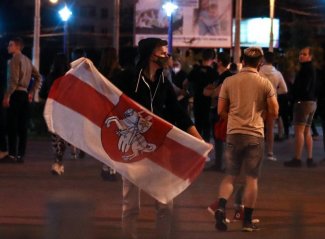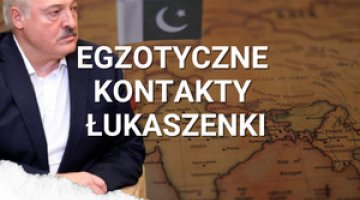Fourth day of protest in Belarus

More anti-regime demonstrations were seen across the country on 12 August. The protests spilled outside the main protest centres (Minsk, Homel, Hrodna, Vitebsk, Baranovichy, Maladzyechna) to other regional cities and numerous small towns and villages whose residents had not previously opposed the government. The number of protesters in each location ranged between the hundreds in small towns to the thousands in larger ones, and most likely exceeded 10,000 in Minsk. Unlike on the previous days, the protests took the form of ‘solidarity chains’ consisting predominantly of women demanding changes and stopping the bloodshed. More peaceful women’s pickets were seen in the streets all over Belarus on 13 August early in the morning. A considerable number of people also gathered in front of detention centres to hear news about their family members. Around 6,000-7,000 people have been detained since Sunday. Although acts of violence committed by law enforcement forces are still numerous (another, third, fatality has been confirmed), the pacifications are no longer happening on such a massive scale and in such an aggressive manner as in the previous days.
The first cases of dialogue between militia officers and demonstrators have been observed, and assurances that the militia will no longer use violence have been heard. Some lower-ranking militia servants have also appealed for an end to the beating of protesters. More than ten recordings have been published most likely showing predominantly former law enforcement officers (who served in OMON and other special units of the Ministry of Internal Affairs) casting away their uniforms as a sign of protest against the brutal response from the law enforcement forces. Several well known journalists quit their jobs on national television.
Most of the independent websites that had been blocked since 9 August resumed their operation on Wednesday morning. Over 500 representatives of the IT sector (the most dynamic sector of Belarusian economy, generating a 5% share in GDP) published an open letter to the government, insisting on the return of unlimited access to the Internet and an end to the repressions. Otherwise they would not rule out moving their businesses abroad. Regardless of the numerous calls in community networks for an industrial strike and blocking public transport, very few factory crews have expressed their protest against the official election results. Two exceptions to this tendency are: the fertiliser manufacturer Grodno Azot and the plastic yarn manufacturer Khimvolokno, both based in Hrodna. However, both factories are continuing production.
Alyaksandr Lukashenka convened a meeting on 12 August to discuss the situation in the country. He stated during the meeting that the main tasks are: protecting the constitution, ensuring the proper functioning of the state apparatus and protecting the economy from collapse. The president once again contemptuously branded the demonstrators as the “unemployed with a criminal past” who should be “forced into” honest work. At the same time, state television published a report suggesting that the protests are allegedly being controlled and the demonstrators are being paid to participate in them by the former campaign staff of Viktar Babaryka, who is currently in detention. In turn, the Minister of Internal Affairs Yury Karayeu, in response to the numerous complaints about the way the law enforcement forces treated journalists yesterday, warned his subordinates that no acts of violence towards the media would be tolerated. However, such incidents have still been seen, albeit on a smaller scale.
Commentary
- The emergence of the ‘solidarity chains’ as a new form of protest is a response to the terror which a section of the Belarusian public has been subjected to by the brutality of the law enforcement forces over the past few days. The women predominating in such protests express their growing certainty that it is necessary to reduce the tension to avoid further acts of violence. The outstandingly peaceful form of such gatherings and women’s participation in many cases prevented the law enforcement forces from resorting to the pacification measures they had applied with regard to other forms of demonstrations.
- The scale of the law enforcement forces’ actions has been visibly reduced, though they are still extremely brutal in many cases (rubber bullets and stun grenades are no longer used so frequently). This may be linked to the reducing radicalism among the protesters, as they were less eager to build barricades and engage in fights with the law enforcement troops than on previous days. The situation is being stabilised by the passive stance adopted by the crews of large factories who, despite expressing their protest, have not discontinued their work and have not joined the demonstrators. It is also worth noting that the number of people being released from detention is clearly growing. This may suggest that the government is thus trying to reduce the tension, though this might also be an effect of insufficient space in detention centres.
- All these are signs indicating that the public protests will continue but will evolve to take more peaceful forms (human chains, static pickets). This, along with growing numbers of accounts given by the participants of the first phase of protests who are being released from detention, may contribute to an increase in the number of the demonstrators. Furthermore, Lukashenka’s statements do not completely match the situation, since he has not given up his confrontational narrative based on totally discrediting his opponents and conspiracy theories; this may mobilise the public to participate in the demonstration in greater numbers. The participation of large groups of citizens in various forms of protest will certainly result in increasing civil and national consciousness among the Belarusian public. The historical white-red-white flags are the predominant symbol visible among the protesters.
- Regardless of the changing form and reduced dynamic of the protests, nothing suggests that the public outrage has lessened. A continuation of these actions during the next few days or weeks may lead not only to further weakening of the regime’s control of the public (which has already noticeably eroded) but also to first serious divides inside the elite, including law enforcement structures. Although only a few cases of disobedience among lower-ranking militia servants and journalists representing the state media have been seen so far, it cannot be ruled out that a wave of disobedience will also spill to higher levels. Therefore, it is in Lukashenka’s interest to extinguish the protests as they are a threat to his regime.





